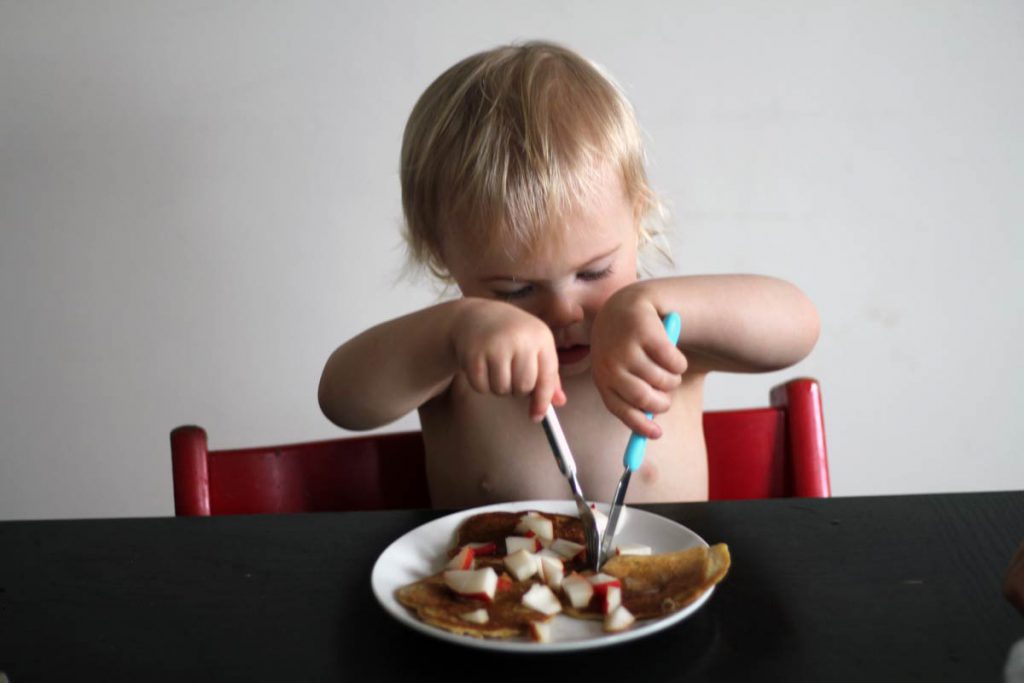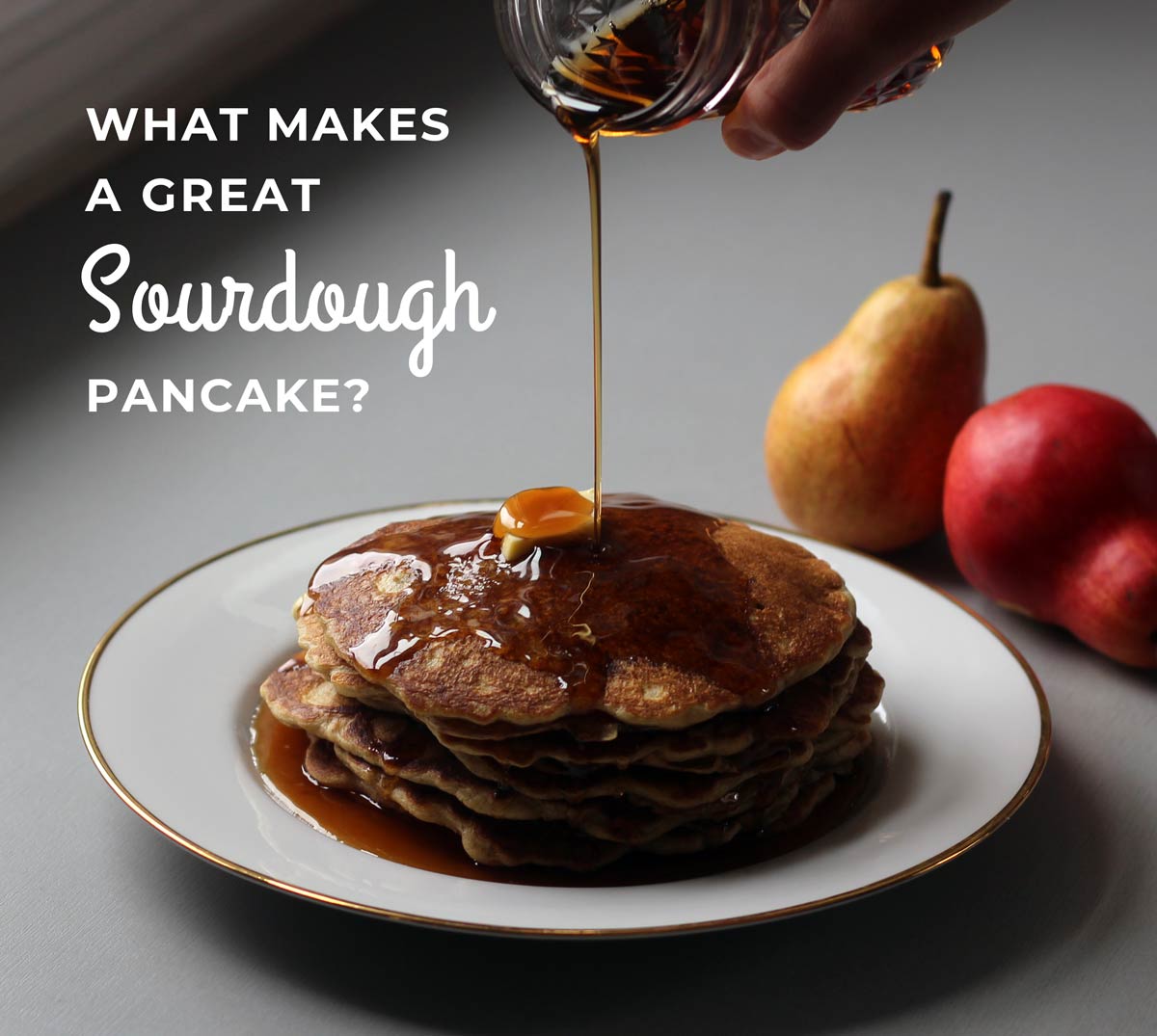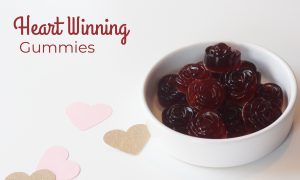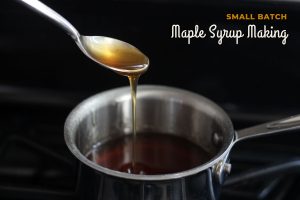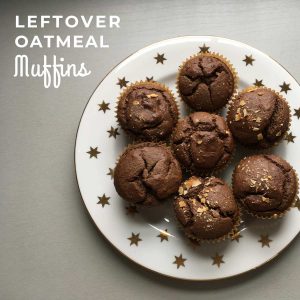We’ve had more than a few pancake breakfasts this year to celebrate and share our homemade maple syrup. The rustic sourdough pancakes we make consistently get rave reviews from guests. I think the simple recipe I’ve evolved over a few years is also about as healthy as pancakes can get.
Now delicious and healthy can be subjective matters, so I’ll lay out my thoughts on the subject. Let’s talk pancakes…
What makes a delicious sourdough pancake?
- Real sour sourdough: This may not be everyone’s preference, but I just love a nice, tangy sour flavor to my pancakes. It tastes real. It tastes complex. I feel even a slight connection to the rustic hearth and table of early Americans settlers. It’s just so much more interesting than the predictable, flat, single-note pancake most restaurants serve. Many sourdough pancakes are so subtle, you can barely tell they are sourdough. Nope. I want to taste it. This is one reason I don’t dilute my sourdough with additional flour right before making pancakes, as many “sourdough” recipes call for. These sourdough pancakes are made with 100% sourdough fermented overnight.
- A well-greased pan: You know you’re in for a treat when you see that intriguing, irregular texture that signals a pancake with rustic character and flavor. You bite through that slightly crispy, mottled brown crust and the hint of bacon flavor gives way to a contrasting soft and slightly sweet center. This full-bodied pancake experience is the result of a well-greased pan, my friends. To get that every time, you need to apply plenty of grease between every round of pancakes. Don’t get stingy or skip a time or two or your pancakes will take a turn towards a blah uniformity of color that dulls the senses. ALSO, the type of grease matters. Save your coconut oil. Forget your Wesson. Nothing imparts flavor like bacon grease, or butter in a pinch. We always save our bacon grease for this purpose and it is ideal for pancakes in flavor and function. Butter will add nice flavor too, but burns if it gets too hot. Oh, and do yourself a favor and only make pancakes in a cast-iron pan.
- Plenty of egg: Preferences vary on this one, but I see a spectrum running from the thick and dry (a.k.a. “fluffy”) fall-apart pancakes that give you that mouth-full-of-flour feeling, to a thin dense pancake (think Swedish pancake or crepe). This spectrum is all about the ratio of egg to flour. More egg, more Swedish. Personally, I prefer my pancakes on the Swedish side of things. This recipe is not a Swedish pancake by any means, but is towards the Swedish side of middle, with density and substance, or what you might call “fluff”.
- A flavorful sweetener: Pancakes generally call for a sweetener, which assists with the browning. For health reasons and general deliciousness, I’ve just decided to go with banana as our standard pancake sweetener. Who doesn’t love a banana pancake? Of course nothing tops it off and completes the rustic sourdough experience better than 100% pure maple syrup (which you can make yourself!) There really is NO need to add processed sugar or even honey to your pancake recipe. But now I’m drifting into our next topic…
What makes a healthy sourdough pancake?
- Partially digested grains: Gluten is extremely difficult to digest, which can lead to a myriad of health problems. Even if you haven’t been diagnosed with an intolerance, I think it just makes sense to ease the burden on your digestive system. Traditionally, our ancestors put grains through various process that helped pre-digest the food for them. (And that was before our modern grains, bred to maximize the gluten!) Fortunately, the sourdough fermenting process allows good bacteria to pre-digest the flour, reducing our digestive load. (Additionally, fermenting reduces phytic acid, an anti-nutrient that blocks absorption of important minerals.) Many sourdough pancake recipes call for a combination of sourdough and flour. No way! Let those bacteria do their work for you! I have found that you can use ALL sourdough that has been fermenting overnight. This may result in a more sour pancake, but (maybe thanks to the bananas?) we haven’t found anybody who didn’t love it.
- No added sugar or honey: I don’t add any sugar to these pancakes. Hopefully you are well aware of the harmful effects of processed sugar! As mentioned, I use bananas as the sole sweetener. I don’t like to go overboard with fruit in my family, but believe it preferable to pure processed cane sugar. (I used to use raw honey, but have stopped using honey in all cooking and baking after reading this fascinating discussion. It appears that heating honey not only reduces it’s beneficial qualities, but eating heated honey may have a harmful effect on humans.)
- Good fats: The latest research affirms the traditional wisdom of using natural fats over the highly processed fats popularized in the mid-twentieth century. Coconut oil, used in the pancake batter, is an excellent choice. Pork fat is also highly nourishing when well-sourced. (The high nutritional value, particularly vitamin D, comes from exposure to the sun so buying pasture-raised products is essential.) This is why we always save the bacon grease! I never feel guilty frying the pancakes in plenty of bacon grease and slathering them up with butter afterwards, knowing that we buy pasture-raised meat and dairy.
- Real and simple toppings: The best way to turn this delicious and nourishing breakfast into a source of future health problems is to slather it up with sugary processed toppings. Please don’t buy the cheap syrups in the store that are mostly made of corn syrup/sugar and some flavoring. Do your current and future self a favor and buy 100% pure maple syrup. (Or get out there and make your own — you only need one tree!) Alternatively or additionally, cook up some apples or berries to make a simple sweet sauce without any added sugar.
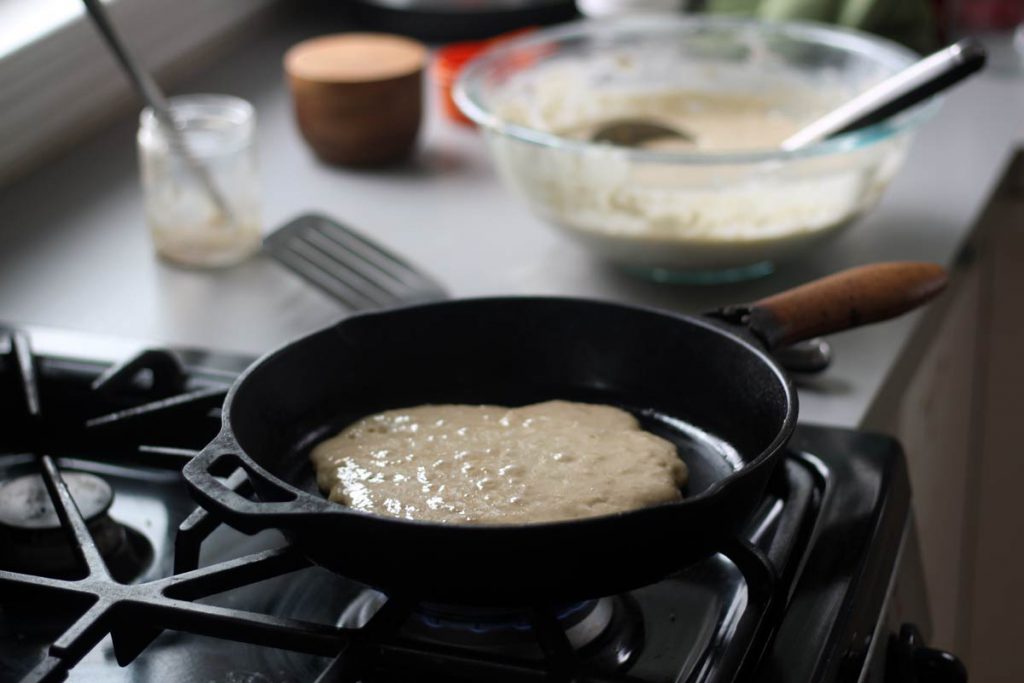
Delicious and Nourishing Rustic Sourdough Pancake Recipe
Ingredients:
- 2 cups sourdough starter (wheat, rye, einkorn, a blend, it all works!)
- 2 ripe bananas
- 1/4 cup coconut oil
- 2 eggs
- 1/2 teaspoon salt
- 1 teaspoon baking soda
- Quality grease for the pan (ideally leftover pastured bacon grease, or could use butter or coconut oil in a pinch)
Directions
- Prepare the sourdough ahead of time. I will usually begin growing my start at some point the day before, depending on how big a batch of pancakes I will make. (If it’s been in the fridge for a while it will take longer to wake up, and depending on how big your start is you don’t want to add too much flour at one time — a general rule of thumb is to add enough flour to double the start every couple of hours.) My goal is to have the complete 2 (or 4, or 6) cups of sourdough put together and starting to ferment the night before.
- Mash the bananas. (This is an excellent step for toddler participation — we’ll sometimes put the bananas in a plastic baggie and let them go at it with a plastic hammer…)
- Gently melt the coconut oil over low heat. (Only if necessary! If the house is warm your coconut oil may already be runny!)
- Add all ingredients except baking soda into the sourdough and combine thoroughly. Don’t mix more than necessary to preserve as much live sourdough activity as possible.
- Sprinkle baking soda over batter and mix in quickly. Add this last because baking soda is activated as soon as it hits wet ingredients, and the airy bubbles will dissipate over time.
- Heat and grease your pan over medium low. Preferably with leftover bacon grease, but butter or coconut oil will do.
- Pour batter, flip when edges appear dried and the bubbles have popped, and serve when nicely browned on both sides.
- Re-grease and repeat!
Am I alone in my sour, sourdough obsession? I’m sure we’ve all formulated our own opinions on this common breakfast standard. What do you think makes a delicious and nourishing pancake? Pin this recipe to your Pinterest board if you want to have the full-bodied rustic sourdough pancake experience like this little guy!
